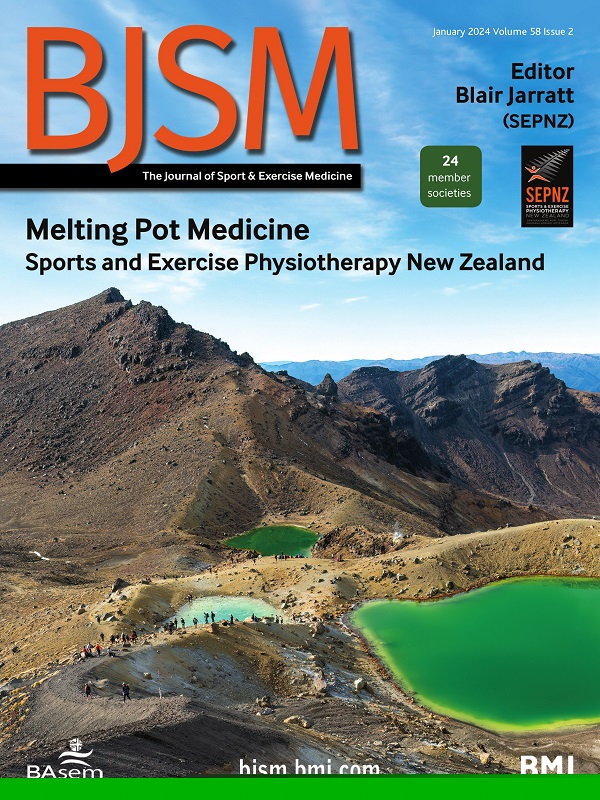Carbon monoxide inhalation to increase haemoglobin mass: a canary in a coal mine for sport?
IF 11.6
1区 医学
Q1 SPORT SCIENCES
引用次数: 0
Abstract
The desire to enhance athletic performance drives research into potential ergogenic aids. Carbon monoxide (CO) is a colourless, odourless and poisonous gas that is difficult to detect, making it known as the ‘silent killer’.1 Despite its toxicity, CO has found varied applications in medicine and sport.2–9 Although CO can serve as a tool for monitoring performance gains through the measurement of haemoglobin mass (Hbmass),8 9 research surrounding its potential use as an ergogenic aid has raised ethical concerns.1 This editorial describes the legitimate applications of CO in sports and ways it may be exploited as an ergogenic aid to enhance athletic performance. At the turn of the 20th century, pioneering research by John Haldane revealed that CO binds to haemoglobin with greater affinity than oxygen, forming carboxyhaemoglobin (COHb), limiting the oxygen-carrying capacity of the blood and leading to anaemic hypoxia.2 This finding stemmed from Haldane’s earlier research on miners that led to his idea of using canaries in coal mines. These birds, more sensitive to CO, were used as early warning signs to detect toxic gas levels, alerting miners to evacuate before CO concentrations became lethal. The toxic effects of CO are proportional to COHb concentrations, with moderate adverse effects (eg, fatigue, headache, nausea) typically presenting with COHb >10–20% and progressing in severity to heart failure, coma and death as COHb concentrations increase.2 These fundamental discoveries, coupled with advances in respiratory physiology and gas analysis techniques, laid the foundation for the applications discussed herein. One of the most significant advancements was the development of the CO rebreathing …吸入一氧化碳增加血红蛋白量:煤矿里的金丝雀运动?
提高运动成绩的愿望推动了对潜在的人体免疫助剂的研究。一氧化碳(CO)是一种无色、无味、有毒、难以探测的气体,被称为“无声杀手”尽管一氧化碳具有毒性,但它在医学和体育运动中有着广泛的应用。2-9虽然一氧化碳可以作为一种工具,通过测量血红蛋白质量(Hbmass)来监测运动成绩的提高,但围绕其作为一种促红细胞生长素的潜在用途的研究已经引起了伦理问题这篇社论描述了CO在体育运动中的合法应用,以及它可能被利用为提高运动成绩的助剂的方式。20世纪初,约翰·霍尔丹(John Haldane)的开创性研究表明,CO与血红蛋白的结合比氧更有亲和力,形成羧血红蛋白(COHb),限制了血液的携氧能力,导致贫血性缺氧这一发现源于霍尔丹早期对矿工的研究,这导致了他在煤矿中使用金丝雀的想法。这些鸟类对CO更敏感,被用作检测有毒气体水平的早期预警信号,在CO浓度达到致命水平之前提醒矿工撤离。CO的毒性作用与COHb浓度成正比,具有中度不良反应(如疲劳、头痛、恶心),通常表现为COHb浓度为10-20%,随着COHb浓度的增加,其严重程度进展为心力衰竭、昏迷和死亡这些基本发现,加上呼吸生理学和气体分析技术的进步,为本文讨论的应用奠定了基础。最重要的进步之一是CO呼吸的发展……
本文章由计算机程序翻译,如有差异,请以英文原文为准。
求助全文
约1分钟内获得全文
求助全文
来源期刊
CiteScore
27.10
自引率
4.90%
发文量
217
审稿时长
3-8 weeks
期刊介绍:
The British Journal of Sports Medicine (BJSM) is a dynamic platform that presents groundbreaking research, thought-provoking reviews, and meaningful discussions on sport and exercise medicine. Our focus encompasses various clinically-relevant aspects such as physiotherapy, physical therapy, and rehabilitation. With an aim to foster innovation, education, and knowledge translation, we strive to bridge the gap between research and practical implementation in the field. Our multi-media approach, including web, print, video, and audio resources, along with our active presence on social media, connects a global community of healthcare professionals dedicated to treating active individuals.

 求助内容:
求助内容: 应助结果提醒方式:
应助结果提醒方式:


